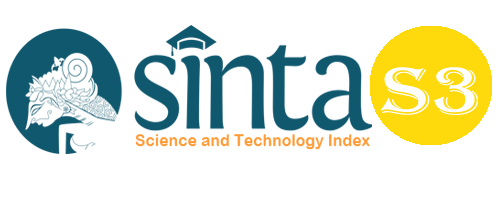Implementation of Data Mining to Determine Payment Delays for Mall Shopping Center Tenants Using K-Means Clustering Method
Abstract
With the rapid growth of their business, XYZ Company wanted to utilize their data to the upmost maximum. One of the methods to make the most out of their data is to do data mining. With the available data and RapidMiner as processing tool, researcher can build a clustering model to determine the accuracy of payment for their clients. It was discovered that the dataset can be divided into 3 clusters, namely on time, late, and very late. From the cluster discovered, a suggestion can be made on how to handle the payment for each group, so that there will be no more late payment in the future by applying a penalty for the tenants that are late paying their bills.
Keywords
Full Text:
PDFReferences
Achenbach, A., & Spinler, S. (2018). Prescriptive analytics in airline operations: Arrival time prediction and cost index optimization for short-haul flights. Operations Research Perspectives, 5(July), 265–279. https://doi.org/10.1016/j.orp.2018.08.004
Aprilla Dennis. (2013). Learn Data Mining with Rapidminer. Innovation and Knowledge Management in Business Globalization: Theory & Practice, Vols 1 and 2, 5(4), 1–5. http://esjournals.org/journaloftechnology/archive/vol1no6/vol1no6_6.pdf%5Cnhttp:// www.airccse.org/journal/nsa/5413nsa02.pdf
Brandt, T., Wagner, S., & Neumann, D. (2021). Prescriptive analytics in public-sector decision-making: A framework and insights from charging infrastructure planning. European Journal of Operational Research, 291(1), 379–393. https://doi.org/10.1016/j.ejor.2020.09.034
Chen, L. H., & Kang, F. Sen. (2010). Integrated inventory models considering permissible delay in payment and variant pricing strategy. Applied Mathematical Modelling, 34(1), 36–46. https://doi.org/10.1016/j.apm.2009.03.023
Choi, Y., Yoon, G., & Kim, J. (2022). Unsupervised learning algorithm for signal validation in emergency situations at nuclear power plants. Nuclear Engineering and Technology, 54(4), 1230–1244. https://doi.org/10.1016/j.net.2021.10.006
Choudhari, A. S., & Potey, M. (2018). Predictive to Prescriptive Analysis for Customer Churn in Telecom Industry Using Hybrid Data Mining Techniques. Proceedings - 2018 4th International Conference on Computing, Communication Control and Automation, ICCUBEA 2018, 1–6. https://doi.org/10.1109/ICCUBEA.2018.8697532
Damayanti, S. E. (2006). Analisis Dan Implementasi Framework Crisp-Dm (Cross Industry Standard Process for Data Mining) Untuk Clustering Perguruan Tinggi Swasta. Jurnal STT Bandung.
Desineedi, R. M., Mahesh, S., & Ramadurai, G. (2020). Developing driving cycles using k- means clustering and determining their optimal duration. Transportation Research Procedia, 48(2018), 2083–2095. https://doi.org/10.1016/j.trpro.2020.08.268
Fan, C., & Xiao, F. (2017). Assessment of Building Operational Performance Using Data Mining Techniques: A Case Study. Energy Procedia, 111(September 2016), 1070– 1078. https://doi.org/10.1016/j.egypro.2017.03.270
Gladju, J., Kamalam, B. S., & Kanagaraj, A. (2022). Applications of data mining and machine learning framework in aquaculture and fisheries: A review. Smart Agricultural Technology, 2(April), 100061. https://doi.org/10.1016/j.atech.2022.100061
Hartanto, D. (2020). Sociology Review of Social Phenomenon, Social Rules and Social Technology. Budapest International Research and Critics Institute-Journal (BIRCI-Journal) Vol 3, (2): 1175-1184.
Khumaidi, A. (2020). Data Mining for Predicting the Amount of Coffee Production Using CRISP-DM Method. Jurnal Techno Nusa Mandiri, 17(1), 1–8. https://doi.org/10.33480/techno.v17i1.1240
Laperrière-Robillard, T., Morin, M., & Abi-Zeid, I. (2022). Supervised learning for maritime search operations: An artificial intelligence approach to search efficiency evaluation. Expert Systems with Applications, 206(April), 117857. https://doi.org/10.1016/j.eswa.2022.117857
Larose, D. T., & Larose, C. D. (2014). Discovering Knowledge in Data: An Introduction to Data Mining. Wiley.
Mauritsius, T., Braza, A. S., & Fransisca. (2019). Bank marketing data mining using CRISP- DM approach. International Journal of Advanced Trends in Computer Science and Engineering, 8(5), 2322–2329. https://doi.org/10.30534/ijatcse/2019/71852019
Miranda, E. (2008). Pengembangan Business Intelligence Bagi Perkembangan Bisnis Perusahaan. CommIT (Communication and Information Technology) Journal, 2(2), 111. https://doi.org/10.21512/commit.v2i2.501
Mosavi, N. S., & Santos, M. F. (2020). How prescriptive analytics influences decision making in precision medicine. Procedia Computer Science, 177, 528–533. https://doi.org/10.1016/j.procs.2020.10.073
Naik, A., & Samant, L. (2016). Correlation Review of Classification Algorithm Using Data Mining Tool: WEKA, Rapidminer, Tanagra, Orange and Knime. Procedia Computer Science, 85(Cms), 662–668. https://doi.org/10.1016/j.procs.2016.05.251
Schröer, C., Kruse, F., & Gómez, J. M. (2021). A systematic literature review on applying CRISP-DM process model. Procedia Computer Science, 181(2019), 526–534. https://doi.org/10.1016/j.procs.2021.01.199
Šikšnys, L., Pedersen, T. B., Liu, L., & Özsu, M. (2016). Prescriptive analytics.
Encyclopedia of Database Systems, 1–2.
Sikumbang, E. D. (2018). Penerapan Data Mining Penjualan Sepatu Menggunakan Metode Algoritma Apriori. Jurnal Teknik Komputer AMIK BSI (JTK), Vol 4, No.(September), 1–4.
Solano, J. A., Lancheros Cuesta, D. J., Umaña Ibáñez, S. F., & Coronado-Hernández, J. R. (2021). Predictive models assessment based on CRISP-DM methodology for students performance in Colombia - Saber 11 Test. Procedia Computer Science, 198(2020), 512–517. https://doi.org/10.1016/j.procs.2021.12.278
Tinoco, J., Parente, M., Gomes Correia, A., Cortez, P., & Toll, D. (2021). Predictive and prescriptive analytics in transportation geotechnics: Three case studies. Transportation Engineering, 5(May), 100074. https://doi.org/10.1016/j.treng.2021.100074
Václav, C., Gabriel, F., Blanka, K., Libor, K., & Michal, T. (2021). Utilization of business intelligence tools in cargo control. Transportation Research Procedia, 53(2019), 212– 223. https://doi.org/10.1016/j.trpro.2021.02.028
Wieder, B., & Ossimitz, M. L. (2015). The Impact of Business Intelligence on the Quality of Decision Making - A Mediation Model. Procedia Computer Science, 64, 1163–1171. https://doi.org/10.1016/j.procs.2015.08.599
Zhang, L., Qi, Z., & Meng, F. (2021). A Review on the Construction of Business Intelligence System Based on Unstructured Image Data. Procedia Computer Science, 199, 392– 398. https://doi.org/10.1016/j.procs.2022.01.048
DOI: https://doi.org/10.33258/birci.v5i3.6080
Article Metrics
Abstract view : 66 timesPDF - 37 times
Refbacks
- There are currently no refbacks.

This work is licensed under a Creative Commons Attribution-ShareAlike 4.0 International License.

This work is licensed under a Creative Commons Attribution-ShareAlike 4.0 International License.

_.gif)

















_.gif)



